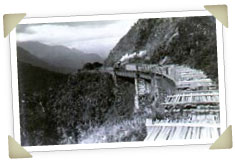The construction of the
railway officially started on February 1880, and it was considered
an impossible enterprise by many European Engineers. Its
construction has began simultaneously in three sites: between
Paranaguá and Morretes (42 km), between Morretes and Roça Nova (38
km) and between Roça Nova and Curitiba (30 km).

It aimed to communicate
the cities of the Paraná coastal region to the State capital city,
Curitiba, in order to foster social development. Moreover, it was
essential to connect the Paranaguá port to the Brazilian southern
states, so as they could export their crops, in order to ensure
their economic growth.

More than 9000 men were
hired, and they received from 2000 to 3000 réis per working day. Most of
them lived in Curitiba or the coastal region, and they were mainly
immigrants that worked in rural activities. More than 50% of these
workers died during the construction of the railway, due to the
precarious safety conditions.
The effort and attitude
of workers, engineers and other professionals resulted in one of the
most daring worldwide engineering constructions. After 5 years, the
railway was inaugurated on February 2, 1885. Engineers, Federal and
local authorities, journalists and other guests participated in the
inaugural journey between Paranaguá and Curitiba, which lasted 9
hours; at the arrival, more than 5 thousand citizens welcomed the
train.

Along 110 kilometers of
railway, the passenger has the opportunity to appreciate hundreds of
engineering works of art: 14 tunnels, 30 bridges and many big
viaducts. The São João Bridge, with its height of 55 meters, and the
Carvalho Viaduct, which is connected to the Rochedo tunnel and is
supported by five mortar pillars placed on the mountain slope, stand
out due to their unique characteristics.

Few destinations in
Brazil have the historic background of the Serra Verde Express
journey. The company is committed to maintaining the railway in
operation in a sustainable way, respecting the Atlantic Forest that
surrounds the railway and all the people that makes its operation
possible: tourists, employees and other tourism-related
professionals.